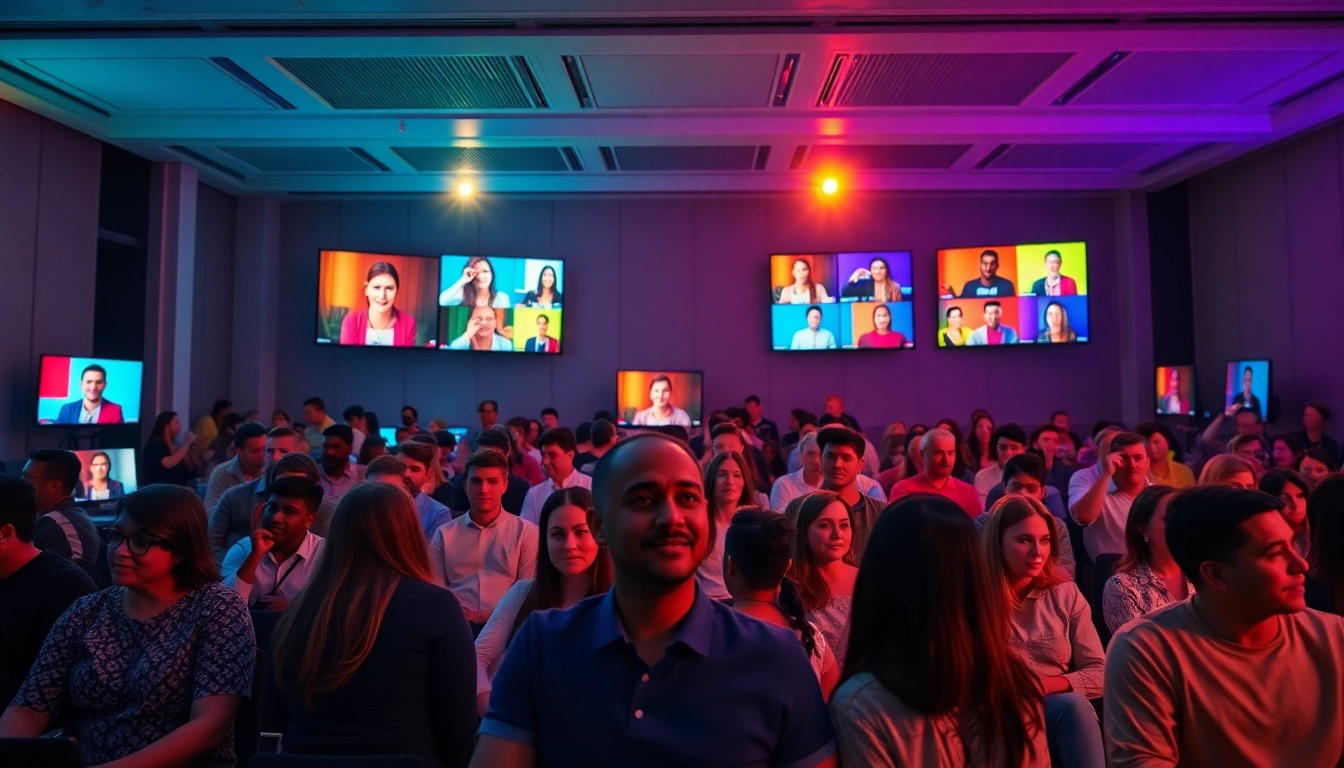Enhancing Engagement with the Virtual Audience System for Modern Events
Understanding the Virtual Audience System
Definition and Key Features
The Virtual Audience System (VAS) is an innovative platform designed to enhance the experience of both presenters and attendees in a virtual event setting. At its core, a VAS allows for seamless interaction and engagement between the audience and presenters, leveraging technology to create an immersive experience. Key features of a Virtual Audience System include real-time polling and surveys, Q&A sessions, chat functionalities, and multimedia content sharing. These features aim to break down the barriers of traditional broadcasting by allowing for more dynamic participation from audience members, regardless of their physical location. Furthermore, the system can provide data analytics following the event, giving organizers insights into audience engagement and content effectiveness.
Benefits of Using a Virtual Audience System
The shift towards virtual events has been accelerated by recent global circumstances, necessitating innovative solutions for audience engagement. Implementing a Virtual Audience System offers numerous benefits:
- Increased Accessibility: Participants can join from anywhere, eliminating travel barriers.
- Cost-Effectiveness: Reduces expenses associated with venue rentals and logistics.
- Expanded Reach: Organizations can attract a global audience, growing their potential participant base.
- Enhanced Engagement: Interactive features foster real-time participation, keeping attendees focused and invested.
- Data Insights: Analytics can guide future event decisions, helping organizers refine their strategies based on audience behavior and preferences.
How It Differs from Traditional Systems
Compared to traditional event systems, which often rely heavily on one-way communication, a Virtual Audience System supports two-way interactions that can significantly enhance participant engagement. Traditional methods typically include passive presentations without immediate feedback or interaction opportunities. In contrast, VAS encourages engagement through features designed to facilitate interaction, such as live polling, chat functions, and breakout sessions that allow for smaller group discussions. This shift not only enriches the event experience but also contributes to higher retention rates and more meaningful takeaways for participants.
Getting Started with a Virtual Audience System
Choosing the Right Platform
When selecting a Virtual Audience System, it’s crucial to assess various platforms to find one that aligns with your specific needs. Considerations should include:
- User-Friendly Interface: Ensure that the platform offers an intuitive design that can be easily navigated by both presenters and attendees.
- Feature Set: Look for essential features such as real-time interaction tools, engagement analytics, and integration capabilities with other software.
- Scalability: Choose a platform that can accommodate your audience size, ensuring seamless performance regardless of the number of participants.
- Technical Support: Reliable customer support is vital for troubleshooting any issues that may arise during your event.
- Pricing Structure: Compare cost-effectiveness in terms of features offered, scalability, and ROI.
Setting Up for Your First Event
Preparation is key to a successful virtual event. Start by defining clear objectives and outcomes you wish to achieve. Follow these steps to set up for your first event:
- Plan Your Content: Develop an agenda that includes engaging topics, speakers, and interactive segments.
- Promote the Event: Utilize email marketing, social media, and partnerships to spread the word and encourage registrations.
- Rehearse with Speakers: Conduct run-throughs with all presenters to ensure familiarity with the platform and content.
- Technical Test: Run tests on the chosen Virtual Audience System to identify any technical glitches.
- Engagement Strategy: Prepare engaging content that utilizes the platform’s interactive features to keep your audience involved.
Essential Technical Requirements
To ensure a seamless experience during your event, certain technical requirements must be met. They include:
- Stable Internet Connection: A strong, uninterrupted internet connection is essential for both presenters and attendees to avoid disruptions.
- Compatible Devices: Ensure that all participants have access to the necessary devices, whether desktops, laptops, or mobile devices, and that the chosen platform is supported.
- Audio and Visual Equipment: High-quality microphones and cameras can significantly improve the experience and engagement level.
- Backup Systems: Prepare alternative solutions and backup systems to mitigate risks in case of technical issues.
Best Practices for Maximizing Engagement
Interactive Features to Include
Maximizing audience engagement during virtual events is essential for creating an impactful experience. Integrating various interactive features can facilitate this:
- Live Polling: Allow attendees to express their opinions on key topics in real-time.
- Q&A Sessions: Dedicate time for audience questions to foster deeper discussions.
- Virtual Breakout Rooms: Enable smaller group discussions for more intimate interactions.
- Gamification: Introduce game-like elements such as quizzes and challenges to incentivize participation.
- Feedback Surveys: Conduct surveys at different intervals to gather immediate feedback on the event experience.
Crafting Engaging Content
Content plays a crucial role in keeping an audience engaged. Consider these strategies to enhance your content:
- Storytelling: Use narratives and testimonials to create a connection with your audience, making content relatable.
- Variety of Formats: Diverse formats such as videos, infographics, and live demonstrations keep the audience interested.
- Short, Digestible Segments: Break discussions into shorter sessions to maintain attention and prevent information overload.
- Visual Aids: Use visuals that enhance understanding and retention of the information shared.
Collecting Audience Feedback Effectively
Feedback is vital for improving future events and understanding audience needs. Employ the following strategies:
- Post-Event Surveys: Distribute surveys immediately after the event for fresh and honest feedback.
- Follow-Up Emails: Send personalized emails thanking attendees and requesting further insights.
- Social Media Engagement: Use platforms like Twitter and LinkedIn to gather audience comments and reactions.
- Focus Groups: Organize small focus groups to discuss specific aspects of the event in detail.
Case Studies of Successful Virtual Audience System Implementations
Corporate Events and Conferences
Many organizations have successfully utilized Virtual Audience Systems to host corporate events and conferences. For instance, a tech company recently leveraged a VAS for a global conference, attracting thousands of participants. The event featured multiple keynote speakers, breakout sessions, and real-time engagement tools like live Q&A and polls, resulting in impressive engagement metrics and a notable increase in attendee satisfaction compared to previous in-person events.
Virtual Fundraisers and Charity Events
Non-profits and charity organizations are also embracing virtual platforms for fundraising initiatives. A noteworthy example is a recent charity gala that used a Virtual Audience System to reach donors across several countries. With innovative engagement features, such as live donation tracking and interactive bidding, the organization raised more than double their initial goal, showcasing the potential of virtual systems to facilitate generosity and community support.
Education and Online Learning
Educational institutions have increasingly turned to virtual systems for online learning. A major university successfully transitioned their seminars to a Virtual Audience System, allowing for real-time interaction between students and instructors. Incorporating features like breakout sessions for group work and live polls to gauge comprehension ensured that students remained engaged, resulting in improved learning outcomes and overall satisfaction with the course delivery.
Measuring Success and Performance Metrics
Key Analytics to Track
Measuring the success of virtual events is critical in refining future strategies. Key performance metrics include:
- Attendance Rates: Analyze the number of attendees compared to registrations to assess interest and engagement.
- Engagement Levels: Track interactions such as polls, questions asked, and time spent in sessions.
- Content Performance: Evaluate which sessions were most attended and received positive feedback.
- Conversion Rates: For fundraising events, track the number of donations received against expectations.
- Feedback Scores: Aggregate responses from post-event surveys to gauge overall satisfaction.
Evaluating Audience Engagement
To truly understand how engaged your audience was, consider using a combination of quantitative and qualitative data. For example, while attendance rates provide a numerical figure, audience feedback can offer insights into the qualitative aspects of their experience. Metrics such as unique interactions, comments made during live chats, and the number of questions asked must be cross-referenced with personal data collected during surveys. This holistic approach allows organizers to identify strengths and areas for improvement.
Adjusting Your Strategy Based on Data
After collecting performance data, it’s essential to take actionable steps based on the insights gathered. This could involve modifying future content to better align with audience interests, adjusting promotional strategies to target specific demographics more effectively, or implementing new engagement tools that have proven successful in previous events. Continuous evaluation fosters improvement and establishes a cycle of growth that enhances the efficacy of virtual audience systems in future events.














Post Comment